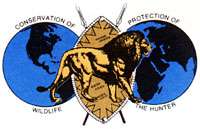Safari Club International
 | |
| Motto | First for Hunters |
|---|---|
| Formation | 1973 |
| Headquarters | Tucson, Arizona |
Membership | 50,000 |
| Website |
www |
Safari Club International (SCI) is an international organization composed of hunters dedicated to protecting the freedom to hunt and promoting wildlife conservation. SCI has more than 50,000 members and 180 local chapters. SCI members agree to abide by the organizations code of ethics which includes making a positive contribution to wildlife and ecosystems, complying with game laws and assisting game and fish officers.[1]
Safari Club International Foundation, the 501(c)(3) branch of SCI, funds and manages worldwide programs dedicated to wildlife conservation, outdoor education and humanitarian services.[1] The organization has taken a stance against poaching.[2]
Leadership
Safari Club International was founded by C.J. McElroy and fellow hunters in 1972. Early chapters were founded in Los Angeles, Chicago, Dallas, Denver, Houston, Arizona and Mississippi. McElroy was an accomplished hunter, hunting on 6 continents and in nearly 50 countries with over 200 record book specimens. SCI's organizational structure is composed of the President, Vice President, and regional directors at large, all elected to their posts from within the membership. Presidents are elected to a term of 1 year, Vice Presidents to a term of 2 years.
The organization's headquarters is in Tucson, Arizona. Safari Club International holds an annual convention in conjunction with their Ultimate Hunters' Market exhibition.
Conservation projects
SCI conservation and education programs are conducted by Safari Club International Foundation, a non-profit organization "dedicated to wildlife conservation, outdoor education and humanitarian services."[3] Although this foundation was set up by SCI and shares board members with SCI, it is a separate legal entity.
Humanitarian services
Sportsmen Against Hunger began in 1989,[4] and through the network of SCI chapters, provides food banks with meat from harvested animals. In 2006, over 250,000 pounds of wild game were donated to charitable relief organizations.[4] The Sensory Safari program allows sight-impaired individuals to get a “visual” perspective of what animals are like by feeling mounts, skins, skulls, horns, and antlers.[5] The National Federation of the Blind (NFB) asked SCIF to host a Sensory Safari at its annual convention. In 1997, the NFB signed a memorandum of understanding with SCI to host Sensory Safaris at all future NFB national and state conventions.[6] Hunters who participate in the SafariCare program take bags filled by SCI chapter with medical, school, and relief supplies to clinics and schools to remote regions of the developing world.[7] The SafariWish program is part of the SafariCare program, designed to give children with life-threatening illnesses a chance to go hunting.[7] The Disabled Hunter program, through SCI chapters, provides sponsorship for hunting trips for disabled sportsmen.[8]
Annual hunters convention

Since 1973, SCI has hosted an Annual hunters convention. In 2013, over 25,000 SCI members, and 1,000 exhibitors participated in the convention.[1]
Publications
The organization publishes a bi-monthly magazine titled Safari that features hunting stories, issues affecting the hunting sportsman, reviews of books and equipment, as well as conservation reports. Safari has a special awards issue, which honors trophy hunters each year.
The news publication of the organization is Safari Times.
Awards
The Safari Club International Record Book is the largest such record keeping system in the world. Trophies are measured and listed according to size (horns, antlers, tusks and/or body size) where taken (free range or estate), how taken (bow and arrow, rifle, muzzleloader) and whether typical or non-typical for the species. Medals and awards are presented dependent on ranking within species. This book ranks every species of game animal using the SCI official scoring method. “Highest scores go to the animals with the largest measurements.”[9] Awards ceremonies are held at the annual Safari Club Convention, Night of the Hunter event.
Political lobbying
In 1979, when SCI was fairly new, it sought government approval to import 1,125 trophies from 40 different species (gorillas, cheetahs, tigers, orangutans, snow leopards, and others) into the US for "scientific research and incentive for propagation and survival of the species." Because the animals were to be hunted, the U.S. Fish and Wildlife Service denied the request.[10]
Polar bear imports
In 1994, SCI successfully lobbied for a change in the U.S. Marine Mammal Protection Act 1972 to allow for the importation of previously banned sport-hunted polar bear trophies into the United States from Canada.[11] In 2007, SCI testified at a U.S. Fish & Wildlife Service hearing opposing the proposed listing of polar bears as a "threatened" species under the U.S. Endangered Species Act. The FWS is concerned that climate change is or will place polar bears at risk of extinction.[12] SCI/SCIF argued that the science cited by the FWS was speculative and incomplete at the time. Relatively healthy populations of polar bears exist in the areas where hunting is allowed and it said that sport hunting of these populations would provide funding for habitat and study as well as income for native populations. SCI stated that, "[...] [T]he U.S. decision to list will merely change the identity of those who hunt the animals from U.S. hunters to exclusively native residents[...]"[13]
Criticism
Endangered species
SCI has been criticised by the Humane Society of the United States (HSUS) for supporting the hunting of endangered African antelope species at fenced "game" ranches in Texas and Florida and for giving awards for the hunting of big cats and leopard, elephant, lion, rhino and buffalo in Africa.[14]
SCI counters that hunting can be an integral part of management of these species and provides needed funds for habitat preservation and enhancement.[15][16] SCI, along with other hunting and non-hunting organizations, intervened in a federal suit where HSUS challenged regulations that allow hunting of captive scimitar-horned oryx, dama gazelle and addax. The U.S. Fish and Wildlife Service (FWS) found that, “[c]aptive breeding in the United States has enhanced the propagation or survival of the scimitar-horned oryx, addax, and dama gazelle worldwide by rescuing these species from near extinctions and providing the founder stock necessary for reintroduction. Sport hunting of surplus, captive-bred animals generates revenue that supports these captive-breeding operations and may relieve hunting pressure on wild populations.”[17] As of February 2008, this case is still pending.[18] In the case of black rhino, 83% of those countries represented at the 2004 CITES meeting approved sport hunting of the species in very limited numbers.[19]
In literature
Dominion: The Power of Man, the Suffering of Animals, and the Call to Mercy, by Matthew Scully, 2003. This book contains extensive details of SCI's annual conference.[20] Scully is a journalist, a former speechwriter for President George W. Bush, and is an avowed conservative Republican.
Revenue sources
For the tax year ending June 2006, SCI reported $2.87 million in revenue from SCI publications, $3.17 million in membership dues, $205,967 in interest on savings and temporary investments, $75,771 from sales of assets other than inventory, $6.86 million from special events such as the annual convention, $156,014 from sales of inventory, and $6,089 miscellaneous income.[21]
In 2007, the New York legislature earmarked $50,000 of public funds for SCI.[22]
References
- 1 2 3 "SCI New Member Welcome Kit" (PDF). Tucson, Arizona: Safari Club International. 2010. Retrieved 2011-03-08.
- ↑ "Groups hope DNA analyses will aid poaching cases - Lifestyle* - MailTribune.com - Medford, OR". MailTribune.com. 2008-07-31. Retrieved 2015-10-17.
- ↑ "Safari Club Foundation". Safariclubfoundation.org. Retrieved 2008-10-27.
- 1 2 "Sportsmen Against Hunger".
- ↑ "Buckeye Bulletin".
- ↑ "SCIF Sensory Safari".
- 1 2 "SafariCare / SafariWish".
- ↑ "Disabled Hunter".
- ↑ name=http://www.scirecordbook.org/login/index.cfm
- ↑ "The Humane Society of the United States, "A View to a Kill: How Safari Club Int'l Works to Weaken ESA Protections"".
- ↑ "The Humane Society of the United States, "Polar Bears Hunted in Dwindling Habitat."".
- ↑ "Safari Club International press release, Outdoor Wire, March 7, 2007.".
- ↑ "SCI Comments on USGS Reports/Polar Bear October 2007." (PDF).
- ↑ The Humane Society of the United States (2005). "Trophy Hunting Groups Asks Federal Court to Endorse "Canned" Hunting of Endangered Animals Trapped Behind Fences". Retrieved 2008-02-12.
- ↑ Safari Club International (2007). "SCIF's Conservation Efforts". Retrieved 2008-02-12.
- ↑ Fred Nelson - and County Foundation Community Based Conservation Network (2006). "Black Rhinoceros Conservation and Trophy Hunting in Southern Africa: Implications of Recent Policy Changes". Retrieved 2008-02-12.
- ↑ U.S Fish and Wildlife Service (2005). "Federal Register: September 2, 2005 (Volume 70, Number 170)". Archived from the original on July 24, 2008. Retrieved 2008-02-18.
- ↑ Endangered Environmental Laws Program (2007). "Recent Cases". Retrieved 2008-02-17.
- ↑ Safari Club International (2007). "CITES Final Report". Retrieved 2008-02-12.
- ↑ Scully, Matthew (2003-10-01). Dominion: The Power of Man, the Suffering of Animals, and the Call to Mercy (paperback). New York City: St. Martin's Griffin. pp. 47–87. ISBN 978-0-312-31973-1. Retrieved 2011-03-09. Lay summary (2002-10-27).
Congress in 1998 lifted a ban on the import of polar bear trophies from Canada. This is one of several legislative victories Safari Club is celebrating here.
- ↑ Archived September 10, 2008, at the Wayback Machine.
- ↑ New York Times. April 11, 2007. “A Budget That Covers All Bases”
External links
- Safari Club International
- Safari Club International - Conservation Efforts Home
- Video of an anti-SCI protest at an annual SCI fundraiser in Foster City, California on 2011-03-05